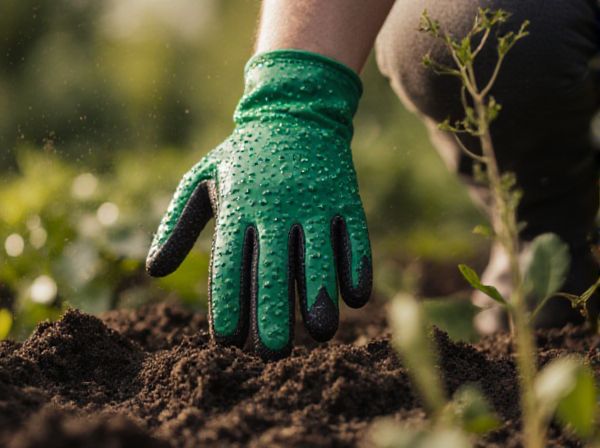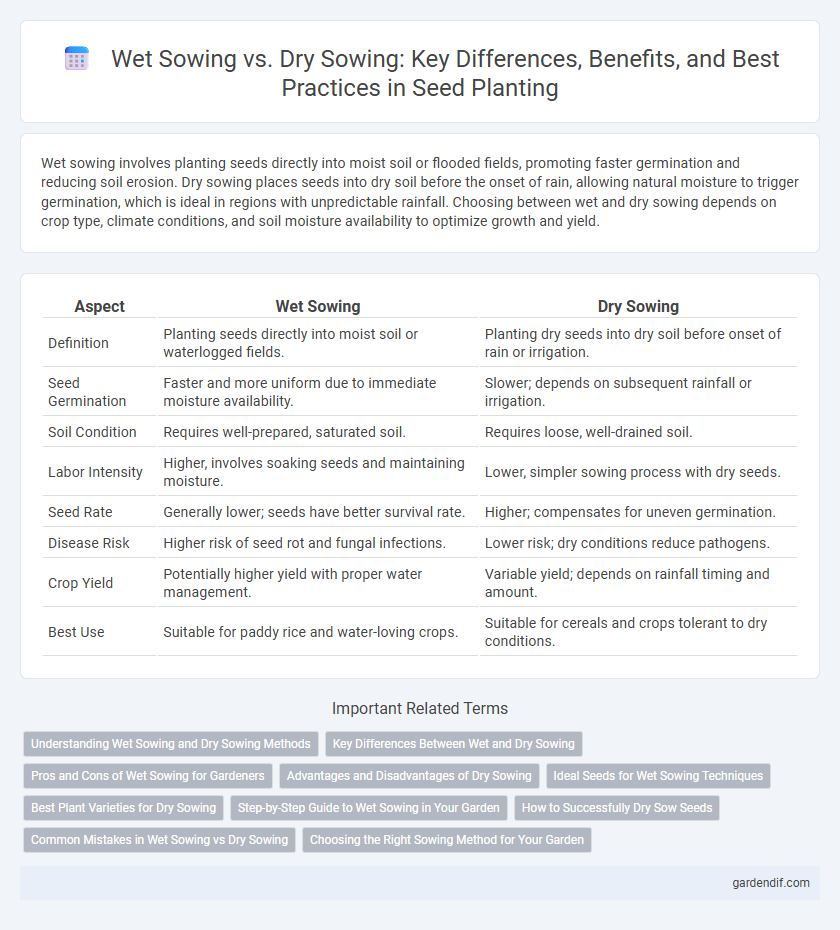
Wet sowing vs Dry sowing Illustration
Wet sowing involves planting seeds directly into moist soil or flooded fields, promoting faster germination and reducing soil erosion. Dry sowing places seeds into dry soil before the onset of rain, allowing natural moisture to trigger germination, which is ideal in regions with unpredictable rainfall. Choosing between wet and dry sowing depends on crop type, climate conditions, and soil moisture availability to optimize growth and yield.
Table of Comparison
| Aspect | Wet Sowing | Dry Sowing |
|---|---|---|
| Definition | Planting seeds directly into moist soil or waterlogged fields. | Planting dry seeds into dry soil before onset of rain or irrigation. |
| Seed Germination | Faster and more uniform due to immediate moisture availability. | Slower; depends on subsequent rainfall or irrigation. |
| Soil Condition | Requires well-prepared, saturated soil. | Requires loose, well-drained soil. |
| Labor Intensity | Higher, involves soaking seeds and maintaining moisture. | Lower, simpler sowing process with dry seeds. |
| Seed Rate | Generally lower; seeds have better survival rate. | Higher; compensates for uneven germination. |
| Disease Risk | Higher risk of seed rot and fungal infections. | Lower risk; dry conditions reduce pathogens. |
| Crop Yield | Potentially higher yield with proper water management. | Variable yield; depends on rainfall timing and amount. |
| Best Use | Suitable for paddy rice and water-loving crops. | Suitable for cereals and crops tolerant to dry conditions. |
Understanding Wet Sowing and Dry Sowing Methods
Wet sowing involves planting seeds directly into moist soil, promoting faster germination and better root establishment by ensuring consistent moisture levels. Dry sowing, on the other hand, places seeds into dry soil, relying on subsequent rainfall or irrigation to activate germination, which can reduce seed rot and improve handling in certain climates. Understanding these methods helps optimize seedling emergence rates and adapt sowing practices to specific environmental conditions.
Key Differences Between Wet and Dry Sowing
Wet sowing involves planting seeds in a moist environment to enhance germination speed and seedling vigor, while dry sowing places seeds directly in dry soil allowing natural moisture to trigger germination. Wet sowing requires careful moisture management to prevent fungal diseases, whereas dry sowing depends on timely rainfall for successful seed sprouting. Key differences include moisture control, germination timing, and risk factors like seed rot in wet sowing versus drought stress in dry sowing.
Pros and Cons of Wet Sowing for Gardeners
Wet sowing offers faster seed germination and better seed-to-soil contact, promoting uniform growth in gardens. However, it requires careful moisture management to prevent seed rot and fungal diseases, posing a risk for inexperienced gardeners. This method is ideal for small seeds and delicate plant species but may increase labor due to the need for frequent monitoring.
Advantages and Disadvantages of Dry Sowing
Dry sowing offers the advantage of easier seed handling and planting in early spring before soil moisture is optimal, reducing the risk of seed rot compared to wet sowing. However, dry sowing may result in uneven germination and slower seedling emergence due to lack of immediate moisture contact. This method requires precise irrigation management to ensure successful seedling establishment and prevent drought stress during critical growth stages.
Ideal Seeds for Wet Sowing Techniques
Ideal seeds for wet sowing techniques typically include fine seeds such as lettuce, carrots, and spinach, which require consistent moisture for optimal germination. These seeds thrive in saturated soil conditions that facilitate quick and uniform sprouting, reducing the risk of seed desiccation and enhancing seedling vigor. Selecting seeds with high moisture tolerance and rapid germination rates maximizes the success of wet sowing practices in agriculture.
Best Plant Varieties for Dry Sowing
Best plant varieties for dry sowing include drought-tolerant crops such as millet, sorghum, and chickpeas, which thrive with minimal moisture during germination. These seeds possess robust seed coats and deep root systems, enhancing water uptake efficiency in dry soil conditions. Selecting varieties like cowpeas and lentils further optimizes yield in arid regions by improving seedling survival rates without pre-irrigation.
Step-by-Step Guide to Wet Sowing in Your Garden
To perform wet sowing effectively, start by soaking seeds in water for 12 to 24 hours to soften the seed coat and enhance germination rates. Prepare your garden bed by loosening soil to a fine texture and ensuring adequate moisture without waterlogging. Sow the soaked seeds evenly, cover lightly with a thin layer of soil or compost, and maintain consistent moisture until seedlings emerge.
How to Successfully Dry Sow Seeds
Dry sowing seeds requires selecting well-drained soil with favorable temperature conditions to prevent seed rot and ensure optimal germination. Seeds should be sown at the appropriate depth, typically two to three times their size, and watered immediately after planting to initiate moisture absorption. Maintaining consistent soil moisture without overwatering promotes healthy seedling development in dry sowing practices.
Common Mistakes in Wet Sowing vs Dry Sowing
Common mistakes in wet sowing include overwatering seeds, which leads to mold growth and poor germination rates. In dry sowing, a frequent error is planting seeds too deep, causing delayed emergence or seed rot due to insufficient moisture. Proper seed depth and moisture levels are critical factors that influence successful seedling establishment in both wet and dry sowing methods.
Choosing the Right Sowing Method for Your Garden
Wet sowing involves planting seeds directly into moist soil, promoting faster germination and reducing the risk of seed displacement by wind or birds. Dry sowing, on the other hand, places seeds in dry soil, allowing them to begin germinating after natural rainfall or irrigation, which suits drought-prone areas. Selecting the appropriate method depends on your local climate, soil moisture levels, and the specific seed type's germination requirements to ensure optimal growth and yield.
Wet sowing vs Dry sowing Infographic

 gardendif.com
gardendif.com